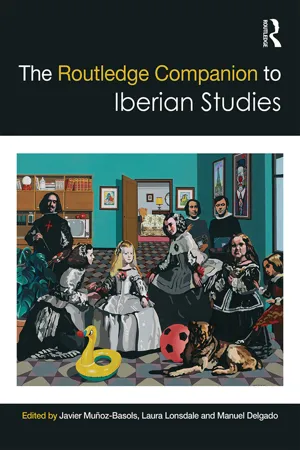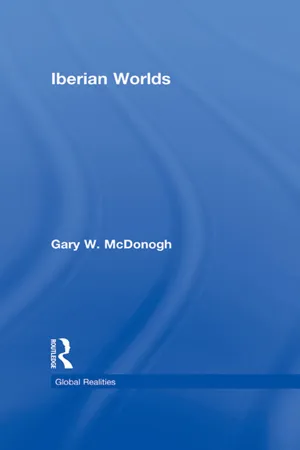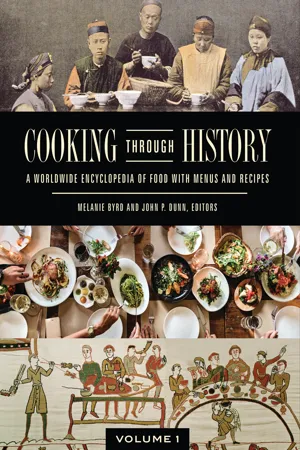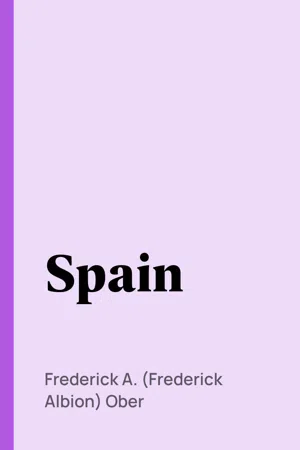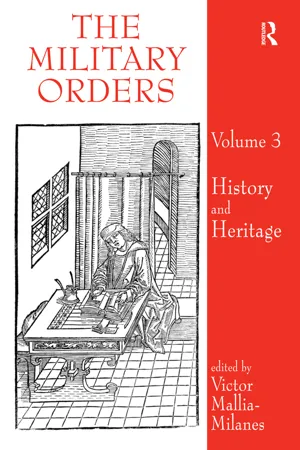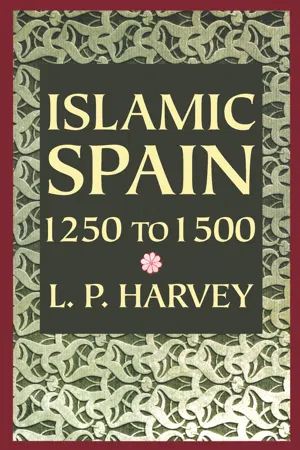History
Iberian Peninsula
The Iberian Peninsula is located in southwestern Europe and is home to the countries of Spain, Portugal, Andorra, and Gibraltar. It is bordered by the Atlantic Ocean and the Mediterranean Sea. The region has a rich history, with influences from various cultures including the Romans, Moors, and Visigoths.
Written by Perlego with AI-assistance
Related key terms
9 Key excerpts on "Iberian Peninsula"
- eBook - ePub
Late Antique and Early Medieval Hispania
Landscapes without Strategy?
- Pilar Diarte-Blasco(Author)
- 2018(Publication Date)
- Oxbow Books(Publisher)
Part I
Hispania (AD 400–711). An historical, archaeological and geographical background
Passage contains an image
Chapter 1
The Iberian Peninsula: a land of multiple landscapes?
Hispania : a geographic and topographic descriptionThe Iberian Peninsula, located in the south-west corner of Europe, comprises two modern counties, Spain and Portugal, and covers an area of approximately 582,000 km2 , making it Europe’s second largest peninsula (behind Scandinavia). It is separated from France by the mountain range of the Pyrenees, which acts as a natural border, while the southern area of the Peninsula is separated from the north-west coast of Africa by the Mediterranean Sea and the narrow Strait of Gibraltar, just c . 15 km wide. It is flanked on the south-east and east by the Mediterranean Sea, and on the north, west and south-west by the Atlantic Ocean. Indeed, the fact that the Peninsula lies between Europe and Africa creates notable influences in terms of surrounding environments and climatology; its position in the Atlantic, African and European plates, together with its tectonic evolution, also creates a particular variation and a diversity of landscapes.Topographic variability is one of the main characteristics of the Iberian Peninsula, with several ranges of mountain chains and basins distributed across all its territory (De Vicente Muñoz and Vegas 2007). The Pyrenees, the Cantabrian Range, the Sistema Central-Cadena Ibérica and the Sierra Morena (from north to south) are the larger main systems of mountain ranges (with a very high mean topography, of c. - eBook - ePub
- Javier Muñoz-Basols, Manuel Delgado Morales, Laura Lonsdale, Javier Munoz-Basols, Manuel Delgado Morales, Laura Lonsdale(Authors)
- 2017(Publication Date)
- Routledge(Publisher)
As we have seen, historians such as F. Schlegel, Sismondi or Bouterwek considered the Iberian Peninsula as a historical and cultural unity that was severed from the rest of Europe and preserved its common peculiarities through time; however, this unity and continuity disappears, as we have also seen, when we consider Spain and Portugal separately. And this is what happens in nineteenth-century literary histories when they are devoted to each of the national literatures, from their birth to the present moment, as we see herein.It is common in Spanish and Portuguese literary historiographies to identify the Middle Ages with the moment when both national characters are created.4 The Middle Ages are the starting point for most literary histories too: the birth of the nation is equated with the birth of the romance languages, and therefore literatures. This medieval period also provides what became a key element in the conceptualization of Iberian literatures: the Islamic conquest of the Iberian Peninsula and the long years of struggle (or peaceful coexistence, depending on the historian) between Eastern and Western peoples.5 This same idea is repeated in almost every history of the nineteenth century (see Pérez Isasi 2011). According to the Romantic vision, the Christian inhabitants of the Iberian Peninsula simultaneously rejected and were influenced by the long centuries of war and cohabitation with the Moors: they fought against them, but also lived with them; they adopted some of their key customs, and reaffirmed some of their own in opposition. This is why the Iberian Peninsula is often referred to as an “Eastern space,” or as a bridge between Europe and Asia: an imaginary locus filled with often fantastic connotations (César Domínguez 2006). Iberian “orientalism” is easier to find, in fact, in the histories written by foreigners, and progressively disappears as the century progresses, and as Iberian scholars contribute more to literary historiography.6 - eBook - ePub
- Gary McDonogh(Author)
- 2008(Publication Date)
- Routledge(Publisher)
Mapping the Iberian Peninsula: Peoples, Places, Culture and History OneTo map Iberian globalization worldwide demands knowledge of the land, peoples and history of the peninsula itself. Geographically, the strong, but not impermeable boundaries of the Pyrenees have cut Iberia off from Europe while oceans—again, both borders and highways—surround it. Yet, the peninsula itself is diverse in ecology, peoples and changes. Four decades ago, for example, Fernand Braudel’s classic overview of the Mediterranean highlighted geographical features central to Iberian cultural ecology: coasts, mountains, and plains/plateaus (Braudel 1966; Horden and Purcell 2000). This landscape, in turn, contrasts with the rough, cold Atlantic shores that have shaped Portugal and Northern Spain. Thus, the first section of this chapter sketches the features of the broad Mediterranean and Atlantic coastal lands and of the central Iberian plateau (Meseta) as ecologies of history.Nonetheless, as we will see again in Africa, Asia and the Americas, Iberian physical environments have become part of human ecologies through millennia of interactions with social, political and cultural features. Portugal, for example, has maintained roughly consistent borders since the thirteenth century. As two modern scholars write, “Portugal has been called an arbitrary, or even accidental country … Yet Portugal has survived within what are essentially its present political boundaries for so long a time that its physical geography seems to ratify the decisions of bygone soldiers and kings” (Ortiz Griffin and Griffin 2003: 172). Spain, on the other hand, still comprises “pieces” whose geographies, boundaries and relations have evolved amid violent disputes over the constitution of empires and states (Roseman and Parkhurst 2008). In the second section, I show how terms such as nation, state and nationality have been forged within Iberian history, including the autonomous communities of contemporary Spain. These Iberian cultures and peoples, in turn, have extended into wider worlds as conquerors, immigrants and refugees, while absorbing global influences. - eBook - ePub
Cooking through History
A Worldwide Encyclopedia of Food with Menus and Recipes [2 volumes]
- Melanie Byrd, John P. Dunn, Melanie Byrd, John P. Dunn, Melanie Byrd, John P. Dunn(Authors)
- 2020(Publication Date)
- Greenwood(Publisher)
Iberian Peninsula (1800–Present)Historical Overview
If the modern history of Spain and Portugal were compared to a restaurant, the resulting menu would be eclectic and international. The long twentieth century witnessed tremendous change in this corner of southwestern Europe. Both countries transformed from monarchy to republic, to dictatorship, and then back to republic; both experienced violent revolutions; and both had to deal with the collapse of traditional imperialism. This mixture, much like a tapas bar, took Iberia all over the political map, with many issues, such as regional autonomy or national unity, actively debated today.At the start of the nineteenth century, Portugal and Spain seemed to be great powers. Between them, they dominated all of Latin America, large swaths of southern Africa, and even colonial holdings in the Philippines and other Pacific islands. Exotic spices, vast quantities of silver bullion, coffee, sugar, and other valuable products left Iberian colonies to benefit the homeland. Military bases enhanced Spanish and Portuguese naval power, while indigenous peoples could be conscripted to form colonial armies.These many advantages, however, were more than offset by severe internal divisions. Portugal and Spain struggled to absorb the social, economic, political, and military changes fostered by the Enlightenment and French Revolution. Neither state was able to set a course that took it across dangerous shoals marked privilege, rising expectations, faith, and nationalism.This became clear when Napoleon Bonaparte attempted to dominate both countries in 1807. Although never completely successful, the French grabbed most of Spain and drove the Portuguese court into exile. The rather rapid defeats of Spain and Portugal were partially offset by British allies, whose armies kept the Peninsula War going until the final expulsion of French troops in 1814. Still, French initial success made clear Lisbon and Madrid were weak; within a decade, most of their New World colonies gained independence. - eBook - ePub
- Frederick A. (Frederick Albion) Ober(Author)
- 2014(Publication Date)
- Perlego(Publisher)
F. A. O.Washington, D. C. , February, 1899.CONTENTS.
CHAPTER PAGE I. —Ancient Iberia 1 II. —Phœnicians and Carthaginians 6 III. —Spain a Roman province 13 IV. —A kingdom of the Goths 25 V. —The invasion from Africa 36 VI. —The Western Califate 45 VII. —Spain’s heroic age 54 VIII. —Decline of the Moors 63 IX. —Kings of Castile and Aragon 72 X. —Ferdinand and Isabella 82 XI. —How the Moors were subjugated 92 XII. —The fall of Granada 106 XIII. —A memorable reign 113 XIV. —When Spain was great 123 XV. —Charles I and Philip II 133 XVI. —Spain’s religious wars 142 XVII. —The seventeenth century 154 XVIII. —The house of Bourbon 165 XIX. —Charles IV and Bonaparte 176 XX. —The reign of Ferdinand VII 187 XXI. —Isabella II and the Carlists 194 XXII. —From Isabella II to Alfonso XIII 203 XXIII. —Spain and her colonies 212 XXIV. —Cuba’s fight for freedom 222 XXV. —War with the United States 234 XXVI. —Spain at the close of the war 255 XXVII. —The treaty of peace 266 Index 279 SPAIN.CHAPTER I.
ANCIENT IBERIA.In the southwestern corner of Europe, with the Atlantic Ocean on the north and west, and the Mediterranean Sea south and east, lies the Iberian Peninsula, eleven thirteenths of which belong to the country known as Spain. The other two thirteenths pertain to Portugal, a country politically distinct from Spain, but with similar physical features in the main.Although we do not know when it first received its ancient name, Iberia, nor even whence came its very first peoples, yet we know that for ages it has existed as a fair and fertile land, capable of supporting millions of inhabitants.It is essentially a mountainous country, for, first of all, there are the Pyrenees, which partly bound it on the north; the Cantabrian range, in the northwest; the Guadarrama, in the central region; and the Sierras Morena and Nevada, in the south. Between these mountain ranges lie great tablelands and deep valleys, the latter traversed by rivers swift and long, but few of them navigable far from the sea. - eBook - ePub
A Brief History of the Spanish Language
Second Edition
- David A. Pharies(Author)
- 2015(Publication Date)
- University of Chicago Press(Publisher)
3External History of the Iberian Peninsula through the Thirteenth Century
This chapter examines the sociopolitical and cultural events that were crucial in shaping the linguistic configuration of the Iberian Peninsula. We will see that the Romans were not the first group to establish themselves in this region, and that they were also not the last. However, the arrival of the Romans and the subsequent Romanization of the Peninsula are undoubtedly dominant factors in its linguistic history, since the language that the Romans introduced more than two millennia ago is still spoken today in almost every part of the Peninsula. Almost a thousand years after the Roman incursion, the Peninsula witnesses another invasion—that of the Muslims—whose effects in the linguistic configuration of the region are almost equally profound. If indeed the Roman invasion explains the fact that Romance languages are spoken today on the Peninsula, it is the second of the incursions that set in motion the events that eventually made Castilian, rather than one of the other Ibero-Romance varieties, the national language of Spain.Iberian Peninsula before the Arrival of the Romans
The following is a partial list of paleo-Hispanic populations—groups that inhabited the Iberian Peninsula before the arrival of the Romans. Various factors are identified, including their probable origins, when they arrived, where they settled (see map 1 ), and their linguistic contributions to Modern Spanish.• Iberians. This group inhabited a wide area from southeast France (Languedoc, Rosellón) along the Mediterranean coast to Murcia, as well as the valley of the Ebro (originally called the Íber, whence ibero ‘Iberian’). These settlements date from the beginning of recorded history in the region. Since it is has not been possible to translate Iberian inscriptions, the language’s genetic affiliation is not known, though phonological analysis of the inscriptions seems to indicate that it is neither Indo-European nor Basque. For the same reason it has not been possible to identify any definite Iberian relics in the Spanish vocabulary. However, certain words pertaining to domestic and rural life could possibly be of Iberian origin: barro ‘mud’, charco ‘puddle’, boñiga ‘dung’, perro ‘dog’, álamo - eBook - ePub
The Military Orders Volume III
History and Heritage
- Victor Mallia-Milanes, Victor Mallia-Milanes(Authors)
- 2017(Publication Date)
- Routledge(Publisher)
The term ‘Iberian Peninsula’ or ‘peninsular’ refers to a physical feature that relates to present political units. The use of this aseptic term became popular among some Spanish historians a few decades ago, and it still is, as a substitute for ‘Spain’, a name that has been and is considered too reminiscent of the form of nationalism fostered by Franco’s regime. The name Spain is unsuitable for an age that lacked a single political identity in the peninsula and the other ones that are used are highly inappropriate when applied to the Middle Ages. The Crown of Aragon was not confined to the peninsular States. By applying that geographical term, Sicily, Sardinia, and Naples would thus be artificially excluded from their fourteenth- and fifteenth-century political milieu. Why do authors show partiality towards the name ‘Majorca’ and not towards the other islands? Why is the geographical expression used as heading bound to include Valencia but not Naples? James II or Alfonso the Magnanimous would not have understood it. 20 Labels are not innocent terms. The word ‘Hispanic’ specifically applied to the military orders that originated in what is now Spain or Portugal is also misleading, because it again projects into the past the idea and borders of modern nations, and it can easily comply with the highly debatable distinction between national and international orders. A recent general survey carried out by Carlos de Ayala Martínez on these Hispanic institutions did not take into account the Hospitallers and the Templars because their orders had been founded in Outremer. 21 Is an Aragonese Hospitaller or a Valencian Templar less ‘Hispanic’ than a Castilian Calatravan? Ayala’s book is an ambitious project intended to cover the history of the military orders in Spain in the Middle Ages, an impressive attempt to assemble information on printed sources and modern historiography - eBook - ePub
- L. P. Harvey(Author)
- 2014(Publication Date)
- University of Chicago Press(Publisher)
Spain by using such an apparently unambiguous expression as “the Iberian Peninsula,” we find we have created a new problem, because the inhabitants of the peninsula cannot be called Iberians (that is an expression limited to ancient history, or to the contrived ecumenicism of modern times).If we adopt the Arabic name for the Iberian Peninsula, al-Andalus, we do not avoid all difficulties, because in English (and indeed in other modern European languages) the word is used of Islamic as distinct from Christian Spain, but since in Arabic the jazīrat al-Andalus was the whole peninsula, there is always the possibility that the broader sense may be intended.In the Iberian Peninsula in the Middle Ages two major civilizations came into conflict. The words we use to describe that conflict inevitably reflect it in their very semantic structures, and there is no way available to us to talk about what went on in neutral terms, nor is there any way of achieving flat uniformity except from the most biased of partisan viewpoints. What we must do is be aware of the ways in which our vocabulary may lead us astray.Spanish possesses a rich vocabulary to designate the minority religious and cultural groups that existed in the peninsula over the centuries, and English has adopted many of these words. It seems at first sight that we have a tidy set of terms to meet each logical possibility. Besides straightforward Christians and Muslims, we need terms for (a) Christians living under Muslim rule, (b) Christians who are converts from Islam (or descendants of such converts), (c) Muslims living under Christian rule, and (d) Muslims who converted from Christianity (or their descendants). We do indeed find (a) Mozarab (mozárabe), (b) Morisco, (c) Mudéjar, and (d) muladí, but it is important to realize that these are not terms universally applicable over the whole chronological range of peninsular history, and each one of them has a problematical aspect. The question of the proper use of Mozarab(ic) affects a multiplicity of groups over a very long period of time (say, from 711 to ca. 1200). Some would apply it to all subject Christians without exception; the extreme opposite viewpoint restricts the word to those culturally Arabized Christians from the south who took refuge in León in the eleventh and twelfth centuries. The resolution of the problem of how the word Mozarabic ought properly to be employed must be left to specialists; the sole purpose of mentioning the word here is to point out that it gives rise to disagreement and controversy. Of the other three terms mentioned, it should be noted that two, muladί and Morisco, are subject to chronological limitations. By and large muladί is used only of converts from Christianity to Islam in the days of Umayyad rule. (Later the term elche is sometimes used, but it seems to imply that the converts in question are outsiders to the community that has adopted them.) Morisco in the special sense indicated at (b) is not in use until well after 1500 (modern historians may use it from 1500 or so, but it is doubtful whether it actually came into use until about mid-century: before that the Moriscos avant la lettre were simply referred to as nuevos convertidos - eBook - ePub
The Medieval Frontiers of Latin Christendom
Expansion, Contraction, Continuity
- Felipe Fernandez-Armesto, James Muldoon(Authors)
- 2017(Publication Date)
- Routledge(Publisher)
In the Western Hemisphere, the spread of ideological movements stressing Iberian roots; the stimulating effects of residence on American soil of topdrawer peninsular scholars like Altamira, Sánchez Albornoz, Ots Capdequí, Américo Castro and Millares Carlo; 2 the growing study of Ibero-American history in Latin America as well as in the United States; have all stirred a strong new interest in the Iberian Background and posed numerous new problems of historical genesis. The scholarly effects of this can be seen in the activities of the Colegio de México and the Spanish section of the Institute de Investigaciones Históricas of the University of Buenos Aires; the appearance of such periodicals for peninsular studies as the outstanding Cuadernos de Historia de España of Buenos Aires and the Bevista de História of São Paulo; and the readiness of Latin American presses like Losada or the Fondo de Cultura Económica to publish books of the caliber of Sánchez Albornoz' La España, musulmana, Américo Castro's España en su historia, Marcel Bataillon's Erasmo y España and Fernand Braudel's El Mediterrámeo y el mundo mediterráneo en la época de Felipe II. In the Iberian Peninsula itself, furthermore, historical productivity since 1940 in precisely those fields most closely related to the Iberian Background has been abundant. The Portuguese octo-ter-centennial of that year provoked numerous multi-volumed historical sets, special studies, and new national and regional historical periodicals; and while this tide has since inevitably ebbed, important work continues to be produced at the Instituto de Estudos Históricos Dr. Antonio de Vasconcelos of Coimbra, by the Faculdades de Letras of Lisbon and Coimbra, and in provincial historical centers
Index pages curate the most relevant extracts from our library of academic textbooks. They’ve been created using an in-house natural language model (NLM), each adding context and meaning to key research topics.

